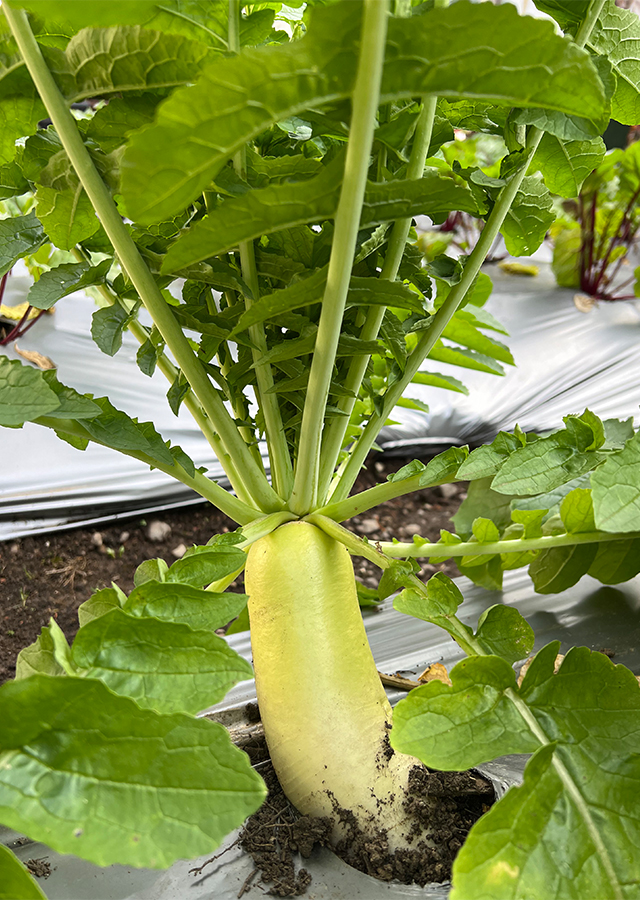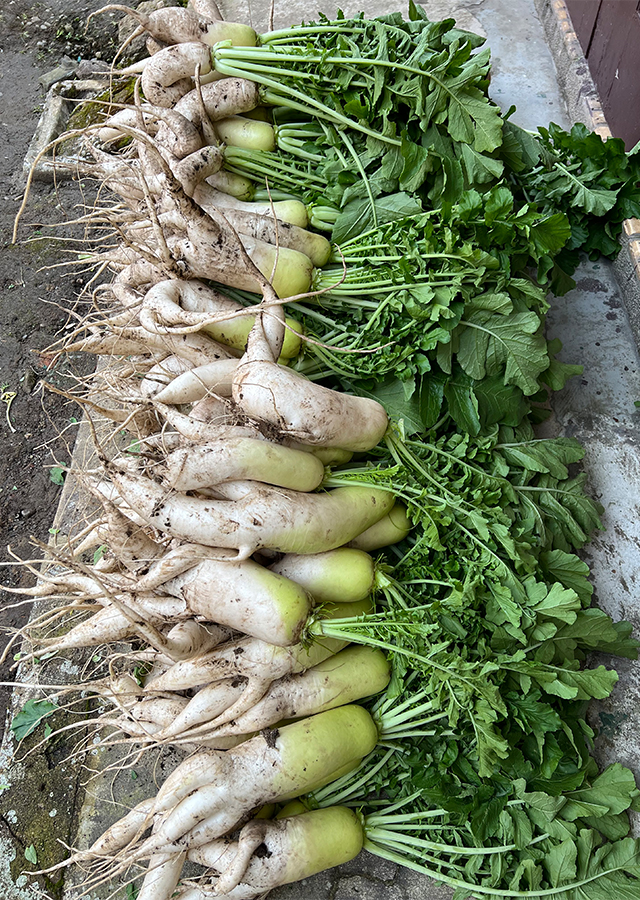Traditional Herbs from Raphanus raphanistrum subsp. sativus
getting wind out of the stomach
- Prepare enough radish roots then peel the skin.
- Wash the radish that has been peeled.
- Grate or blender add enough water.
- Strain then drink.
burns": ["Wash the peeled horseradish root.
What is Raphanus raphanistrum subsp. sativus Looks like??



Parts of Raphanus raphanistrum subsp. sativus that could be used
- Leaves
- Seeds
- Roots
Raphanus raphanistrum subsp. sativus Distribution
Radish is a vegetable plant of unknown origin. The area of ??maximum diversity of radishes is located between the Eastern Mediterranean and the Caspian Sea, which may be the original gene center for this species. Radish was cultivated in ancient times in the Mediterranean (before 2000 BC), where this species spread to China around 500 BC, to Japan around 700 AD and has now spread throughout the world. Today, radishes can also be found as a cultivar throughout the world in various forms. This species is widely cultivated, especially for its thick, fleshy roots. Radish is a vegetable that is ranked very important in Japan, Korea, Taiwan and Yemen. In Southeast Asia, horseradish root is usually used as a cooking ingredient in soups, sauces or meat dishes. Horseradish roots can also be consumed fresh or processed into snacks. Radish leaves can be consumed as salad or spinach. Radish leaves have also been used as green manure in Central and Western Europe, while in South Africa they are generally used as animal feed. Apart from that, radishes also have many health benefits, and have been used as traditional medicine. In India, this plant is widely used as a laxative and expectorant.Agroecology of Raphanus raphanistrum subsp. sativus
Radish can be cultivated in the highlands and lowlands. Radishes are generally a temperate or cool-season crop, where cool conditions stimulate vigorous growth. The best growth in tropical areas is at higher latitudes (>10°) during winter and at high altitudes above 1000 m above sea level. Radish requires light, sandy, deep, well-drained soil, containing high organic matter, with a soil acidity (pH) of 6.0�6.5. Heavy soil can cause deformed roots. The air temperature that is suitable for radish plants is 12.77 - 32 °C, but the optimal temperature is 30 °C and the optimal air humidity is 91%, with average rainfall around 3,500 mm/year. The need for radish plants for water is quite large.
Morphology of Raphanus raphanistrum subsp. sativus
- The taproot, fleshy, contains root hairs. The top of the taproot and hypocotyl become swollen and form a white to red cylindrical tuber, and taper or narrow at the tip, varying greatly in shape and size. Has a mild taste and texture crunchy.
- Leaves alternate, green, unifoliate, glabrous or have several stiff hairs, lower part in a radical rosette, Lower leaves oval (elongated), oval-round ovate (elongated to egg-shaped) to lyrate-pinnatifid (leaf blade divided into lobes that form a feather-like pattern with the largest lobe at the tip), taller leaves are much smaller, short-stemmed, leaf margins more or less dentate.
- Flowers bisexual, fragrant, white to light purple with purple veins. Sepals are free, 4-lobed, petals are free, 4-lobed, spatulate, obtuse to rounded at the apex. Stamens 6, 4 long and 2 short, superior ovary. The inflorescence is a terminal raceme, erect, long, multi-flowered.
- Cylindrical fruit, consisting of 2- several stacked joints, the lower joint is very short and does not bear seeds, the upper part is much larger, and is divided into 2-12 single-seeded compartments, not broken, with a long beak without seeds.
- Seeds are round (ovoid) - ovoid (globose), 3 mm in diameter, yellowish in color.
Cultivation of Raphanus raphanistrum subsp. sativus
- Generative propagation using seeds.
- Radish seeds take about 4-10 days to germinate, at a temperature of 20 - 30 \u00b0C. Plants are harvested within 30 - 50 days after sowing.
Raphanus raphanistrum subsp. sativus, more details :
Chemical Content of Raphanus raphanistrum subsp. sativusAlkaloids (pyrrolidine, phenethylamine, N-methylphenethylamine, 1,2-pyrrolidin-tion-3-yl-3-acid-caroxilic-1,2,3,4-tetrahydro-ß-carbolin, and sinapin), flavonoids (kaempferol, kaempferol 3-O-α-arabinopyranoside, kaempferol 3-O-α- rhamnopyranoside, kaempferol 3-O-β-glucopyranoside-7-O-α-rhamnopyranoside, kaempferol 3-O-α-rhamnopyranoside-7-O-β-glucopyranoside, kaempferol 3,7-di-O-α- rhamnopyranoside, kaempferol 3-O-(2′′−β-glucopyranosyl)-α-rhamnopyranoside-7-O-α-rhamnopyranoside, quercetin 3-O-α- rhamnopyranoside-7-O-α-arabinopyranoside, quercetin 3-O-β-glucopyranoside-7-O-α-rhamnopyranoside, quercetin 3-O-α-rhamnopyranoside-7-O-β-glucopyranoside), glycosides, cardiac glycosides, tannins, saponins, amino acids, terpenoids, steroids, coumarins, phenolic compounds, raphanol, rettichol, essential oils, methylmercaptan, sulfuric acid, erucic acid, four major organic acids (oxalic, malic, malonic and erythorbic acids), ascorbic acid.
Benefits of Raphanus raphanistrum subsp. sativus
Treats asthma, liver disorders, bronchitis, coughs, burns, bruises, diarrhea, stomach ache, hemorrhoids, stomach cancer, overcomes smelly feet, increases urine flow and facilitates defecation, removes wind from the stomach, reduces fever, cures kidney stones and gallstones, increasing breast milk. Has laxative, diuretic, antiscorbutic and antitumor properties.
Simplisia of Raphanus raphanistrum subsp. sativus
- Prepare the roots\u00a0of the radishes, wash them thoroughly under running water.
- Cut the radishes\u00a0so they\u00a0dry easily.
- Dry in the sun or in an oven at a temperature\u00a040 \u00b0C until the moisture content\u00a010%." ,"Blend it using a blender until it becomes powder.
- Store in a clean and airtight place.
Another Facts for Raphanus raphanistrum subsp. sativus :
Synonym of Raphanus raphanistrum subsp. sativusRaphanus sativus L., Raphanus caudatus L., Raphanus radicula Pers.
Habitus of Raphanus raphanistrum subsp. sativus
Herb. Annual herb, between 0.2 - 1 m high
Habitat of Raphanus raphanistrum subsp. sativus
- Mainland
No comments:
Post a Comment